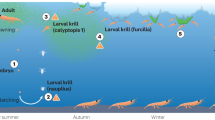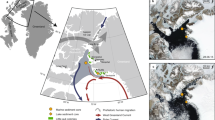Abstract
High-latitude ecosystems are among the fastest warming on the planet1. Polar species may be sensitive to warming and ice loss, but data are scarce and evidence is conflicting2,3,4. Here, we show that, within their main population centre in the southwest Atlantic sector, the distribution of Euphausia superba (hereafter, ‘krill’) has contracted southward over the past 90 years. Near their northern limit, numerical densities have declined sharply and the population has become more concentrated towards the Antarctic shelves. A concomitant increase in mean body length reflects reduced recruitment of juvenile krill. We found evidence for environmental controls on recruitment, including a reduced density of juveniles following positive anomalies of the Southern Annular Mode. Such anomalies are associated with warm, windy and cloudy weather and reduced sea ice, all of which may hinder egg production and the survival of larval krill5. However, the total post-larval density has declined less steeply than the density of recruits, suggesting that survival rates of older krill have increased. The changing distribution is already perturbing the krill-centred food web6 and may affect biogeochemical cycling7,8. Rapid climate change, with associated nonlinear adjustments in the roles of keystone species, poses challenges for the management of valuable polar ecosystems3.
This is a preview of subscription content, access via your institution
Access options
Access Nature and 54 other Nature Portfolio journals
Get Nature+, our best-value online-access subscription
$29.99 / 30 days
cancel any time
Subscribe to this journal
Receive 12 print issues and online access
$209.00 per year
only $17.42 per issue
Buy this article
- Purchase on Springer Link
- Instant access to full article PDF
Prices may be subject to local taxes which are calculated during checkout



Similar content being viewed by others
Data availability
We have made the KRILLBASE-abundance database publically available from the Polar Data Centre at the British Antarctic Survey (http://doi.org/brg8), with supporting metadata31, which should be consulted for further details. Likewise, KRILLBASE-length frequency data are also available on request to the Polar Data Centre, with supporting metadata.
References
Smetacek, V. & Nicol, S. Polar ocean ecosystems in a changing world. Nature 437, 362–368 (2005).
McBride, M. M. et al. Krill, climate, and contrasting future scenarios for Arctic and Antarctic fisheries. ICES J. Mar. Sci. 71, 1934–1955 (2014).
Constable, A. J. et al. Climate change and Southern Ocean ecosystems I: how changes in physical habitats directly affect marine biota. Glob. Change Biol. 20, 3004–3025 (2014).
Tarling, G. A., Ward, P. & Thorpe, S. E. Spatial distributions of Southern Ocean mesozooplankton communities have been resilient to long-term surface warming. Glob. Change Biol. 24, 132–142 (2018).
Steinberg, D. K. et al. Long term (1993–2013) changes in macrozooplankton off the Western Antarctic Peninsula. Deep Sea Res. Pt I 101, 54–70 (2015).
Forcada, J. & Hoffman, J. I. Climate change selects for heterozygosity in a declining fur seal population. Nature 511, 462–465 (2014).
Gleiber, M. R., Steinberg, D. K. & Ducklow, H. W. Time series of vertical flux of zooplankton fecal pellets on the continental shelf of the western Antarctic Peninsula. Mar. Ecol. Prog. Ser. 471, 23–36 (2012).
Schmidt, K. et al. Zooplankton gut passage mobilises lithogenic iron for ocean productivity. Curr. Biol. 26, 2667–2673 (2016).
Wiedenmann, J., Cresswell, K. & Mangel, M. Temperature-dependent growth of Antarctic krill: predictions for a changing climate from a cohort model. Mar. Ecol. Prog. Ser. 358, 191–202 (2008).
Chen, I.-C., Hill, J. K., Ohlemüller, R., Roy, D. B. & Thomas, C. D. Rapid range shifts of species associated with high levels of climate warming. Science 333, 1024–1026 (2011).
Atkinson, A., Siegel, V., Pakhomov, E. A. & Rothery, P. Long-term decline in krill stock and increase in salps within the Southern Ocean. Nature 432, 100–103 (2004).
Siegel, V. & Watkins, J. L. in Biology and Ecology of Antarctic Krill. Advances in Polar Ecology (ed. Siegel, V.) 21–100 (Springer, Basel, 2016).
Whitehouse, M. J. et al. Rapid warming of the ocean around South Georgia, Southern Ocean, during the 20th century: forcings, characteristics and implications for lower trophic levels. Deep Sea Res. Pt I 55, 1218–1228 (2008).
Daufresne, M., Lengfellner, K. & Somner, U. Global warming benefits the small in aquatic ecosystems. Proc. Natl Acad. Sci. USA 106, 12788–12793 (2009).
Loeb, V. et al. Effects of sea-ice extent and krill or salp dominance on the Antarctic food web. Nature 387, 897–900 (1997).
Quetin, L. B., Ross, R. M., Fritsen, C. H. & Vernet, M. Ecological responses of Antarctic krill to environmental variability: can we predict the future? Antarct. Sci. 19, 253–266 (2007).
Meyer, B. et al. The winter pack-ice zone provides a sheltered but food-poor habitat for larval Antarctic krill. Nat. Ecol. Evol. 1, 1853–1861 (2017).
Murphy, E. J. et al. Climatically driven fluctuations in Southern Ocean ecosystems. Proc. R. Soc. B 274, 3057–3067 (2007).
Bintanja, R., van Oldenborgh, G. J., Drifhout, S. S., Wouters, B. & Katsman, C. A. Important role for ocean warming and increased ice-shelf melt in Antarctic sea ice expansion. Nat. Geosci. 6, 376–379 (2013).
Gillett, N. P. & Fyfe, J. C. Annular mode changes in the CMIP5 simulations. Geophys. Res. Lett. 40, 1189–1193 (2013).
Montes-Hugo, M. et al. Recent changes in phytoplankton communities associated with rapid regional climate change along the western Antarctic Peninsula. Science 323, 1470–1473 (2009).
Nicol, S., Foster, J. & Kawaguchi, S. The fishery for Antarctic krill—recent developments. Fish Fisher. 13, 30–40 (2012).
Cox, M. J. et al. No evidence for a decline in the density of Antarctic krill Euphausia superba Dana, 1850, in the Southwest Atlantic sector between 1976 and 2016. J. Crust. Biol. 38, 656–661 (2018).
Ryabov, A. B., de Roos, A. M., Meyer, B., Kawaguchi, S. & Blasius, B. Competition-induced starvation drives large-scale population cycles in Antarctic krill. Nat. Ecol. Evol. 1, 0177 (2017).
Hofmann, E. E. & Murphy, E. J. Advection, krill, and Antarctic marine ecosystems. Antarct. Sci. 16, 487–499 (2004).
Schmidt, K. et al. Seabed foraging by Antarctic krill: implications for stock assessment, bentho-pelagic coupling, and the vertical transfer of iron. Limnol. Oceanogr. 56, 1411–1428 (2011).
Goodall-Copestake, W. P. et al Swarms of diversity at the gene cox1 in Antarctic krill. Heredity 104, 513–518 (2010).
Spiridonov, V. A. A scenario of the late-Pleistiocene-Holocene changes in the distributional range of Antarctic krill (Euphausia superba). Mar. Ecol. 17, 519–541 (1996).
Piñones, A. & Fedorov, A. V. Projected changes of Antarctic krill habitat by the end of the 21st century. Geophys. Res. Lett. 43, 8580–8589 (2016).
Kawaguchi, S. et al. Risk maps for Antarctic krill under projected Southern Ocean acidification. Nat. Clim. Change 3, 843–847 (2013).
Atkinson, A. et al. KRILLBASE: a circumpolar database of Antarctic krill and salp numerical densities, 1926–2016. Earth Syst. Sci. Data 9, 1–18 (2017).
Atkinson, A. et al. Oceanic circumpolar habitats of Antarctic krill. Mar. Ecol. Prog. Ser. 362, 1–23 (2008).
Tarling, G. A. et al. Growth and shrinkage in Antarctic krill Euphausia superba is sex-dependent. Mar. Ecol. Prog. Ser. 547, 61–78 (2016).
Watkins, J. in Krill Biology, Ecology and Fisheries (ed. Everson, E.) 8–39 (Blackwell Science, Oxford, 2000).
Marshall, G. J. Trends in the Southern Annular Mode from observations and re-analyses. J. Clim. 16, 4134–4143 (2003).
Wolter, K. & Timlin, M. S. El Niño/Southern Oscillation behaviour since 1871 as diagnosed in an extended multivariate ENSO index (MEI.ext). Int. J. Clim. 31, 1074–1087 (2011).
Spreen, G., Kaleschke, L. & Heygster, G. Sea ice remote sensing using AMSR-E 89-GHz channels. J. Geophys. Res. Oceans 113, C02S03 (2008).
Murphy, E. J., Clarke, A., Abram, N. J. & Turner, J. Variability in sea ice in the northern Weddell Sea during the 20th century. J. Geophys. Res. Oceans 119, 4549–4572 (2014).
Ross, R. M. et al. Trends, cycles, interannual variability for three species west of the Antarctic Peninsula, 1993–2008. Mar. Ecol. Prog. Ser. 515, 11–32 (2014).
Saba, G. K. et al. Winter and spring controls on the summer food web of the coastal West Antarctic Peninsula. Nat. Commun. 5, 4318 (2014).
Loeb, V. & Santora, J. A. Climate variability and spatiotemporal dynamics of five Southern Ocean krill species. Prog. Oceanogr. 134, 93–122 (2015).
Pinheiro, J., Bates, D., DebRoy, S., Sarkar, D. & R Development Core Team nlme: Linear and Nonlinear Mixed Effects Models R package version 3.1-131 (2017); https://CRAN.R-project.org/package=nlme
R Development Core Team R: a Language and Environment for Statistical Computing (R Foundation for Statistical Computing, 2013).
Fox, J. & Weisberg, S. An R Companion to Applied Regression 2nd edn (Sage Publications, Thousand Oaks, 2011).
Barton, K. MuMIn: Multi-Model Inference R package version 1.9.13 (2013); http://CRAN.R-project.org/package=MuMIn
Hill, S. L., Phillips, A. & Atkinson, A. Potential climate change effects on the habitat of Antarctic krill in the Weddell quadrant of the Southern Ocean. PLoS ONE 8, e72246 (2013).
Acknowledgements
We thank all those who have supplied their data to KRILLBASE, especially A. Baker for help with locating logbooks from the 1920s and 1930s, and R. Hewitt, R. Ross, L. Quetin and S Kawaguchi for provision of data or scientific advice. M. Jessopp, H. Peat and N. Ensor helped with compiling and checking the databases, G. Marshall advised on the SAM indices, F. Perry helped with mapping, D. Ashby helped with the infographic figure, and comments from G. Watters improved the manuscript. S.L.H. was supported by NERC core funding to the BAS Ecosystems programme. A.A. and S.F.S. were funded through NERC’s National Capability modelling, the long-term single-centre science programme ‘Climate Linked Atlantic Sector Science’ (grant number NE/R015953/1), Theme 1.3—Biological Dynamics, and the NERC and Department for Environment, Food and Rural Affairs Marine Ecosystems Research Program (NERC project numbers NE/L003066/1 and NE/L003279/1). D.K.S. was supported by the US National Science Foundation’s Antarctic Organisms and Ecosystems Program (grant PLR 1440435).
Author information
Authors and Affiliations
Contributions
A.A. and S.L.H. provided the initial concept and analysis. A.A., V.S. and E.A.P. conceived and constructed the KRILLBASE databases. A.A., E.A.P., V.S., C.S.R., V.J.L., D.K.S. and G.A.T. supplied data to KRILLBASE. L.G. performed the mapping. S.L.H. performed the statistical analyses. All authors provided input of ideas to the study and manuscript.
Corresponding authors
Ethics declarations
Competing interests
The authors declare no competing interests.
Additional information
Publisher’s note: Springer Nature remains neutral with regard to jurisdictional claims in published maps and institutional affiliations.
Supplementary information
Supplementary Information
Supplementary Figures 1–5, Supplementary Table 1
Rights and permissions
About this article
Cite this article
Atkinson, A., Hill, S.L., Pakhomov, E.A. et al. Krill (Euphausia superba) distribution contracts southward during rapid regional warming. Nature Clim Change 9, 142–147 (2019). https://doi.org/10.1038/s41558-018-0370-z
Received:
Accepted:
Published:
Issue Date:
DOI: https://doi.org/10.1038/s41558-018-0370-z
This article is cited by
-
Using latent behavior analysis to identify key foraging areas for Adélie penguins in a declining colony in West Antarctic Peninsula
Marine Biology (2024)
-
Grazing by nano- and microzooplankton on heterotrophic picoplankton dominates the biological carbon cycling around the Western Antarctic Peninsula
Polar Biology (2024)
-
Patterns of occurrence of the sub-Antarctic fur seal Arctocephalus tropicalis (Gray 1872) in Southern Brazil: climatic and environmental associations
Polar Biology (2024)
-
The impact of salps (Salpa thompsoni) on the Antarctic krill population (Euphausia superba): an individual-based modelling study
Ecological Processes (2023)
-
Monitoring and modelling marine zooplankton in a changing climate
Nature Communications (2023)



